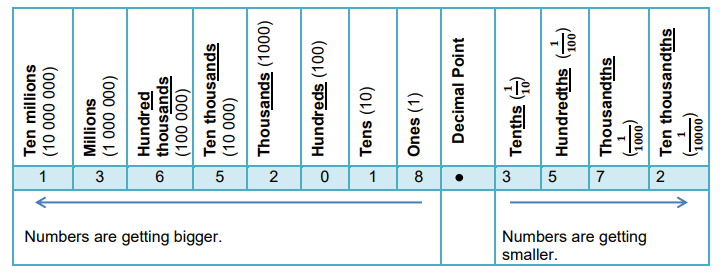Place Values
The value of a digit depends on its place in the Place Value Chart. Numbers to the left of the decimal point represent whole numbers and numbers to the right of the decimal point represent parts of a whole number.
For example, money consists of wholes and parts. Whole dollars ($) are to the left of the decimal point and cents (¢) (parts of a dollar) are to the right of the decimal point.
Place Value Chart
Note: Numbers to the right of the decimal end in “ths” and numbers to the left of the decimal mostly end in “ands” and “eds”.
Example 1:
The number 52 can be broken down into five (5) tens and two (2) ones.
52 = 5 tens + 2 ones 52 = 5 x 10 + 2 x 1
Example 2:
The number 10 568 can be broken down into one (1) ten thousand, zero (0) thousands, five (5) hundreds, six (6) tens and eight (8) ones.
10568 = 1 ten thousand + 0 thousand + 5 hundreds + 6 tens + 8 ones
10568 = 1 x 10 000 + 0 x 1000 + 5 x 100 + 6 x 10 + 8 x 1
Example 3:
The dollar amount $472.65 can be broken down into four (4) hundred dollar bills, seven (7) ten dollar bills, two (2) loonies, six (6) dimes and five (5) cents (or one nickel). $472.65 = 4 hundred dollar bills + 7 ten dollar bills + 2 loonies + 6 dimes and 5 cents (or 1 nickel)
$472.65 = 4 x 400 + 7 x 10 + 2 x 1 + 6 x 0.10 + 5 x 0.01



